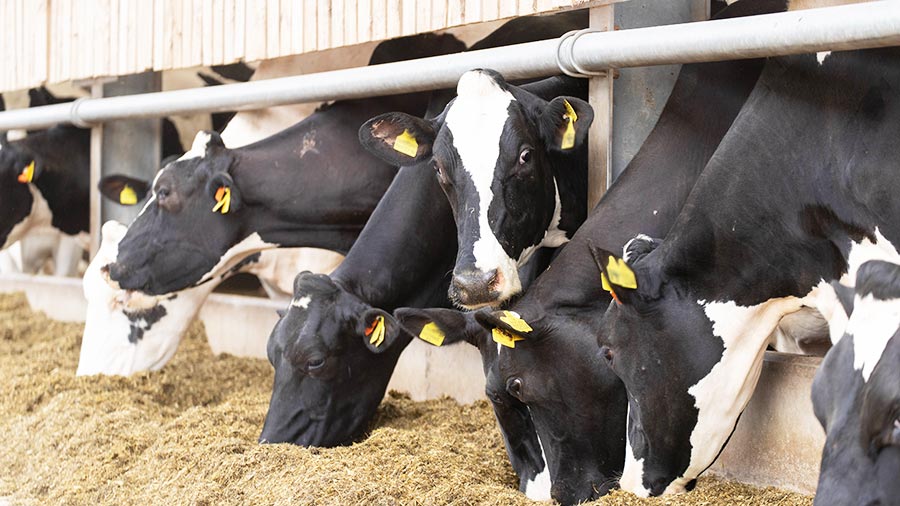2021 maize silage should feed well despite difficult start
 © Tim Scrivener
© Tim Scrivener Results from the first maize silage analysis of 2021 suggest a good-quality crop despite a difficult start to the growing season.
The 2021 crop was drilled later than average after one of the frostiest, driest Aprils held back soil temperatures.
But analysts at Trouw Nutrition’s laboratories says the first 835 samples tested by the company compares well to previous years.
See also: How a farmer cut purchased feed costs by growing grain maize
Trouw’s ruminant technical development manager, Liz Homer, says maize should feed well this winter and complement grass silages.
“Dry matter content is similar to last year on average, at 32.6%, which suggests crops were generally mature at harvest and taken in good conditions,” Dr Homer says.
Starch content up
Energy and D-values are slightly lower than average, but feeds are averaging 11.08MJ/kg dry matter (DM), while starch is 3% higher than last year, at 33.3%.
With starch degradability similar to last year, at 78.4%, there is a range across the samples, largely dependent on dry matter.
Dr Homer explains that starch degradability usually increases with time in the clamp, affecting how maize will feed.
“In wetter silages, starch degradability is generally higher initially and will not change as much over time. Higher dry matter crops will change more with time, becoming more degradable.
“Starch that remains undegraded moves through as bypass starch, which will provide a digestible energy source in the intestine.
“With generally elevated starch content, we will see good levels of bypass starch in all crops,” she suggests.
Complementing grass silage
Dr Homer adds that levels of both rapidly and total fermentable carbohydrates are lower overall in the 2021 crop.
But levels are sufficient to promote rumen fermentation and so complement higher-fibre grass silage.
The maize crop’s lower acid load means it will also feed well with higher-energy, early first-cut grass or any grass silage with a high acid load.
Production from forage
Dr Homer stresses the importance of good clamp management, particularly with drier crops, and recommends regular analysis so that rations can be fine-tuned accordingly.
This winter, farmers should be able to improve production from forage and rumen health, with the maize crop offsetting higher purchased feed costs, she concludes.
Independent nutritionist Hefin Richards adds that, barring some delayed harvests in late-drilled fields, the majority was harvested at the usual time and stage of maturity.
High-yielding crops have allowed some growers to leave a proportion of the crop for combining and crimping. This has been a further bonus, providing a useful tonnage of high-energy, starch-rich maize grain, says Mr Richards, of Rumenation Nutrition Consultancy.
Ration advice
Mr Richards says that maize is a low-protein crop and rapemeal is typically the first choice of supplement feed to balance this.
Unless forward-contracted, rapemeal is proving to be very expensive, at £300/t and, in some cases, difficult to source, he says.
Soya is currently better value in terms of cost for each unit of protein, but some milk contracts preclude or discourage the use of soya.
Urea-based liquids are another widely used option, but feed-grade urea has trebled in price in the past three to four months.
Ideally, farmers should not feed new maize for at least three months after harvest to allow for complete fermentation and breakdown of the proteins that limit starch availability.
In most cases this is not an option, and it is therefore a matter of introducing it gradually and building up inclusions, Mr Richards suggests.
With many first-cut grass silages taken late and having high fibre and low protein contents, cows are generally responding positively to the addition of maize, and total feed costs are potentially lower if proteins have been contracted in advance, he says.
Maize crop quality comparison |
||
|
|
2021 average |
2020 average |
|
Dry matter (%) |
32.6 |
32.1 |
|
D-value (%) |
70.6 |
72.1 |
|
Crude protein (%) |
8.0 |
6.9 |
|
ME (MJ/kg DM) |
11.1 |
11.3 |
|
Starch (% DM) |
33.3 |
30.1 |
|
Starch degradability (%) |
78.4 |
79.8 |
|
Bypass starch (g/kg DM) |
71.4 |
60.4 |
|
Neutral detergent fiber (% DM) |
38.1 |
37.7 |
|
Rapidly fermentable carbohydrates (g/kg DM) |
210.2 |
220.0 |
|
Total fermentable carbohydrates (g/kg DM) |
499.0 |
507.9 |
|
Acid load |
45.7 |
46.8 |
|
Fibre index |
138.7 |
136.3 |
|
pH |
3.84 |
4.0 |
| Source: Trouw Nutrition | ||
